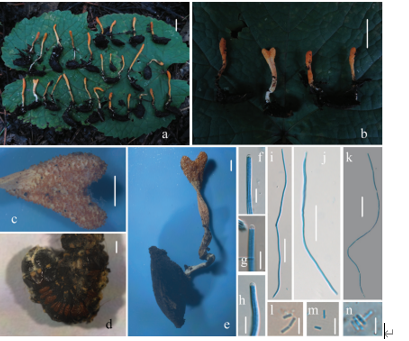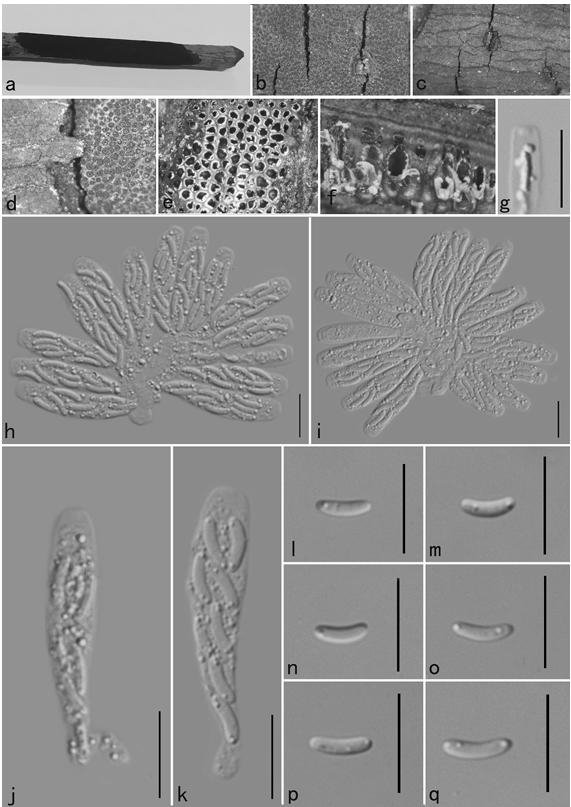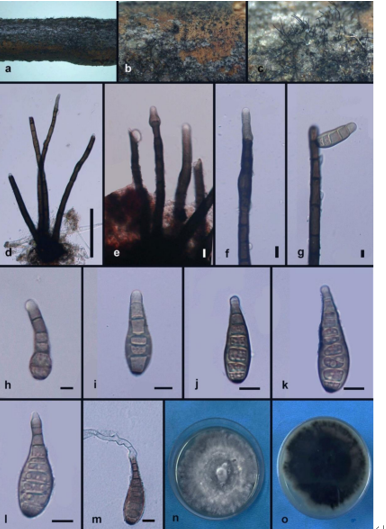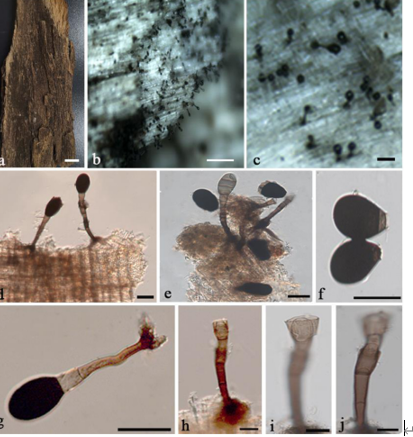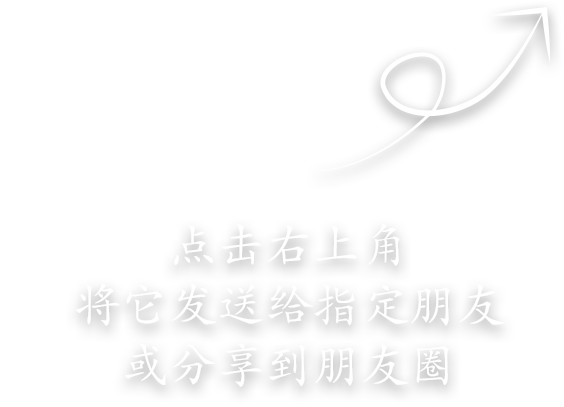Trichoderma ceratophylletum Z.F. Yu & X. Du 2020
Index Fungorum number: IF555895; Facesoffungi number: FoF 05674
Holotype: CHINA, Guizhou Province, Qing Zhen, Hong Feng Lake, within stem submerged in lake, 20 June 2014, YMF1.04621 (holotype).
Morphological description
Sexual morph: Undetermined. Hyphae radiate and branched, dense and abundant on PDA and SNA, relatively sparse on CMD, pustules formed frequently on SNA and CMD, compact, abundant, asymmetrical to hemispherical, usually 0.5–1.5 mm, aggregated to ca. 3 mm diam. Conidiophores tree-like, comprising a straight main axis, often terminating in 3–5 phialides and paired branches, the primary branches arising at right angle from the main axis, terminating in verticils of 3–5 divergent phialides, occasionally unilateral, the distance between two neighbor branches is 9.5–32.3 μm (n = 15). The bases of branches are usually thick, about 2.8–6.1 μm wide (n = 30). Phialides stout, ampulliform to globose, crowded arrangement, (3.7–)4.1–8.4(–9.7) × 2.3–4.1 μm (n = 40), length/ width ratio (1.0–)1.2–2.8(–3.2). Conidia ovoid, sometimes ellipsoid, smooth-walled, at the base usually slightly narrower, greenish in mass, 2.5–3.9 × 1.9–2.9 (–3.2) μm (n = 30), length/width ratio 1.0–1.7.
Culture characteristics: On CMD after 72 h colony radius 56–62 mm, mycelium covers the plate after 96 h at 25 °C. Colonies circular, translucent, margin distinct, aerial hyphae sparse and arachnoid, pustules formed after 4 days. On PDA and SNA, mycelium covers the plate after 72 h at 25 °C. Colonies on PDA distinctly zonate, the zone around central part of colony forms an irregular green ring, aerial hyphae abundant, compact, cottony to downy. Colonies on SNA are similar to PDA, but the aerial hyphae is relatively scarcer than on PDA, pustules formed after one day, turning green after 2 days, distribute on outer layer.
Habitat: On submerged stem.
Distribution: In China.
GenBank Accession: ITS: MK327581; RPB2: MK327580; TEF1: MK327579.
Notes: Trichoderma ceratophylletum phylogenetically forms a single branch (Fig. 58) and is related to T. pleuroti and T. pleuroticola. T. pleuroti differs from T. ceratophylletum by the characteristics of the branches, which are usually Gliocladium-like, with the phialides on the branches often in crowded whorls and not divergent, whereas the branches of T. ceratophylletum are tree-like, and the phialides are commonly divergent in whorls of 3–5. The conidia of T. pleuroti are narrower than those of T. ceratophylletum (2.8–4.2 × 1.6–2.2 vs 2.5–3.9 × 1.9–2.9 μm, Yu et al. 2006). The conidiophores of T. pleuroticola tend to be regularly verticillate, which distinguishs it from the obviously paired branches and tree-like conidiophores of T. ceratophylletum. The phialides of T. pleuroticola are sometimes lageniform and longer (5.5–11.0 vs 4.1–8.4 μm) than those of T. ceratophylletum, which are commonly ampulliform to globose. The conidia of T. pleuroticola are often larger than those of T. ceratophylletum (2.9–4.5 × 2.4–3.5 vs 2.5–3.9 × 1.9–2.9 μm, Yu et al. 2006).
Reference: Hai‑Sheng Yuan1,2· Xu Lu1,2 · Yu‑Cheng Dai3 ·
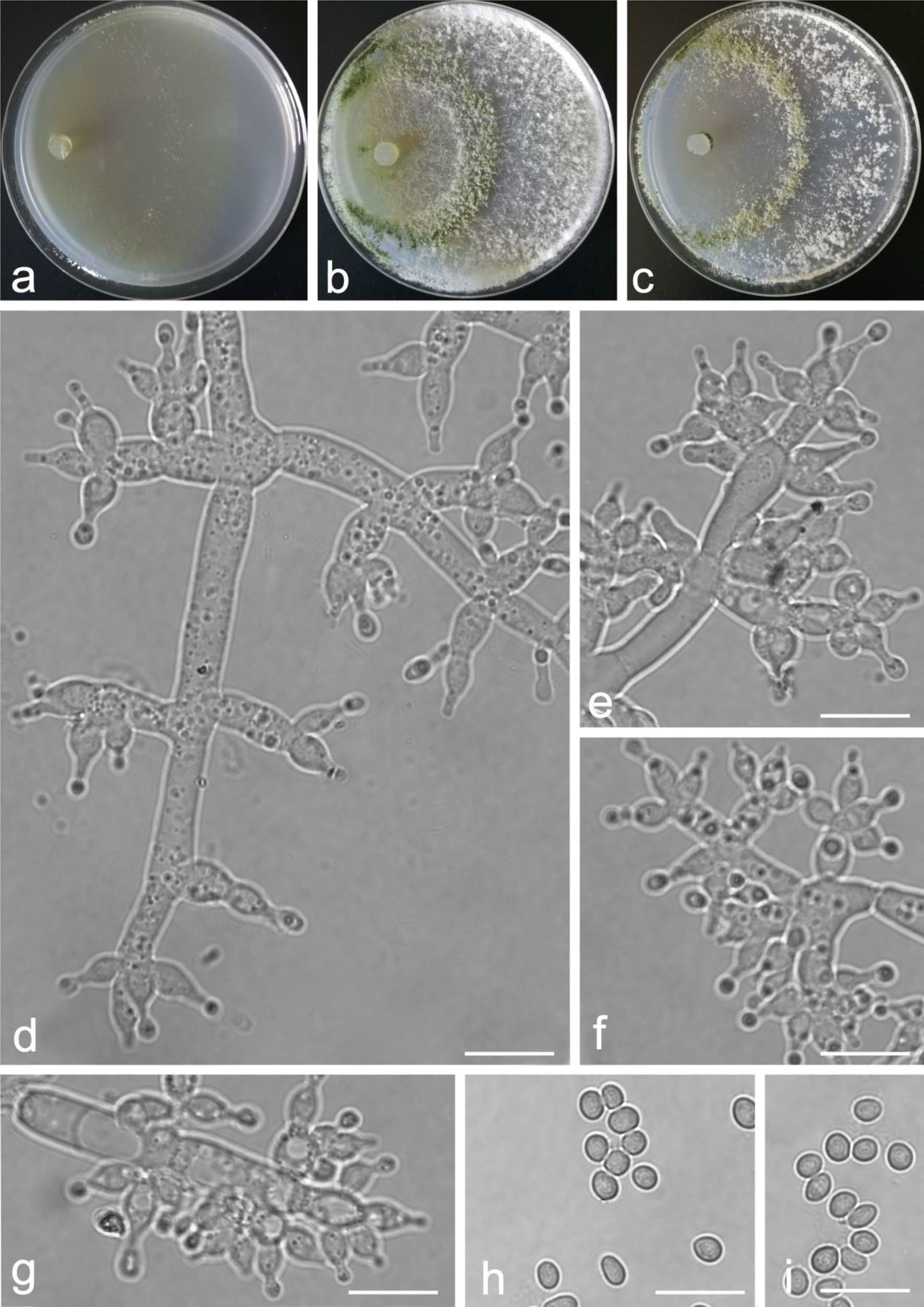
Cultures and anamorph of Trichoderma ceratophylletum (YMF1.04621, holotype). a on CMD at 25 °C, 3 days. b, c Cultures (b on PDA, 3 days. c on SNA, 3 days) at 25 °C. d–g Conidiophores and phialides (SNA, 3 d). h, I Conidia (PDA, 20 d). Scale bars: d–i 10 μm.


